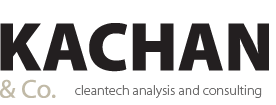Submitted by Dallas Kachan on

Cleantech vendors and marketing firms take note.
Some companies are starting to get savvier about how to introduce their products for maximum market attention and credibility, with a view to speeding their opportunities for success.
As a case in point, borrowing a page from the textbook of successful technology marketing, small Toronto company Cavet Technologies today launched a new breakthrough fluorescent lighting controller product. And it did it well. Theirs wasn’t a vacuous, empty, droning ceremony, but the apex of a carefully orchestrated, months-long process. And beyond the dignitaries, analysts and journalists, there was business being done at the event with distributors and prospects.
Here’s my take on how Cavet pulled off a successful product launch. These points reflect a framework of successful product introductions I’ve been part of in my past as VP of marketing for enterprise software, telecom and other business-to-business companies. Businesses where the average sales price is high, and purchase decisions are made very deliberately.
- Secure a flagship customer – In the world of IT, launching a new product without lead customers, or at least one flagship customer, invites criticism. If a product is supposedly breakthrough and nobody’s using it, just how good could it be? Cavet held its event at a Toronto manufacturing facility of Celestica, a leading worldwide electronics contract manufacturer and Cavet’s manufacturing partner, and also its lead customer and trial site. Cavet actually showed, onstage, its lighting controllers saving the company 40% of the electrical bill for its 50,000 square foot facility.
- Benchmarking – Having market comparison data helps press and analysts understand and appreciate a new product and its performance versus competitors. Third party studies are important. Kachan & Co. played a role in this for the Cavet launch, assembling competitive performance and return-on-investment data, which then formed the backbone of a Cavet Technologies report we published today.
- Third party analyst briefings in advance – Journalists’ expertise is a mile wide and an inch deep. They can’t be experts in everything. Press often require industry experts to help put new technology developments into context. Is a new vendor’s claim really significant or not? In what markets does its product fit? Kachan & Co. served in the role of an analyst, too, for Cavet’s launch, and was subsequently quoted in its press release and stories written about the product introduction. In research for our Cavet report, we interviewed 35 customers, prospects and market influencers.
- Press pre-briefings under embargo for the day of announcement – By sharing its news with a select number of non-competitive journalists several days in advance, Cavet ensured it would have press the morning of its launch. And it did, including high profile articles like this and this.
- Launch event with suitably impressive dignitaries – Cavet gathered investors, distributors and others from its value chain under one roof and took the wrappers off what appears to be a remarkable energy efficiency product. On stage, optimistic about the company’s prospects, were the general manager of partner Celestica, the mayor of Toronto, two provincial cabinet ministers and the company’s lead North American distributor. None spoke for more than 5 minutes, making for a fast-paced session.
- Have customers and partners advocate for you – It’s more persuasive to have others extol your virtues. Cavet recognized this, and kept its own comments onstage to a minimum, letting customers and partners do their talking for them.
- Actually show your product in action – While important to helping the market actually understand a product’s benefits, illustrating the performance of a clean technology product is a challenge to many companies (it’s hard to demonstrate biofuels from algae, for instance.) But Cavet managed, showing a bank of seven of its shoebox-sized controllers saving Celestica 40%-60% of the power previously required to illuminate its manufacturing floor.
- Quantify your benefits – Reducing the power consumption of a given lighting circuit by 40% sounds impressive intellectually. But giving the savings a price—$60 a day in power costs in this case—made the benefits feel real.
- Illustrate your confidence – Cavet doesn’t lack passion for its technology and what it feels is its market opportunity. With an installed cost of less than 10% of most competitors, CEO Albert Behr optimistically told one publication that he wouldn’t rule out a NASDAQ IPO in 2011. That’s confidence.
A former managing director of the Cleantech Group, Dallas Kachan is now managing partner of Kachan & Co., a cleantech research and advisory firm that does business worldwide from offices in San Francisco, Toronto and Vancouver. Its staff have been covering, publishing about and helping propel clean technology since 2006. Kachan & Co. offers research reports, consulting and other services that help accelerate its clients’ success in clean technology. Details at www.kachan.com.
